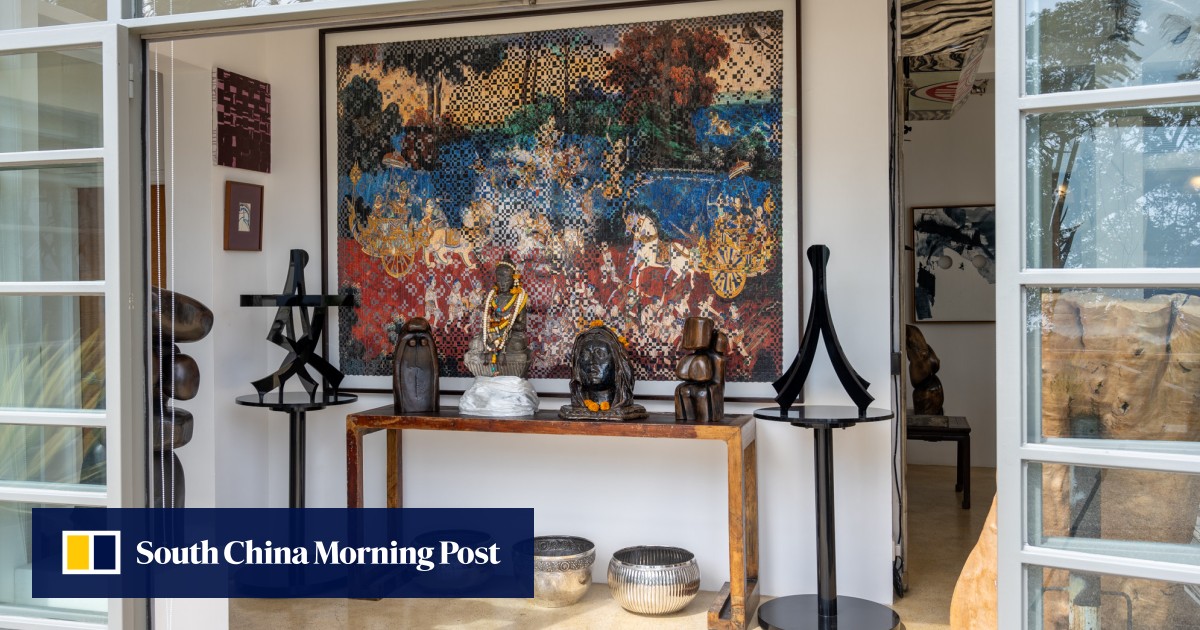Taxi drivers quailed at the address. (They still do.) But the instant the couple saw the incomparable view, they loved it. They still do.
The original house had been a weekender for a Hong Kong couple. It was surrounded by a wall and had tinted windows and a black bathtub. The de Tillys kept to the original footprint, retained the pillars but gutted the interior.
This would be their family home, welcoming in the light and reflecting back their backgrounds and interests.
Artist’s line drawing inspires Hong Kong home design with a Balinese vibe
Artist’s line drawing inspires Hong Kong home design with a Balinese vibe
Katie, who is Californian of Polish extraction, was familiar with the simplicity of the Schindler House in the US city of Los Angeles, which was built in 1922 and triggered the Southern Californian modernist movement.
Although Rudolph Schindler never visited Japan, the Austrian-born American architect’s design was influenced by Japanese architects and Katie liked the idea of those clean lines and rectangular windows returning to Asia.
Georges, who is French, comes from an old European tradition: the floor in their bedroom is made of oak from his family’s forests. Downstairs, the sitting room and dining room floors are of pebble wash, a nod to 1950s and 60s Hong Kong.
Into the two-storey, five-bedroom house they brought a disparate collection of chairs and tables from Shenzhen (modern) and Macau (antique) and two sofas bought in 1994 from Altfield in Landmark Prince’s, in Central on Hong Kong Island.
“The most expensive thing I’d ever bought in my life,” says Katie of that purchase. Those sofas are still going strong but they’re now surrounded by rather more valuable objects.

In this home, art is part of the furniture (literally, in the case of the large wooden bench out on the deck, which was made by Thai artist Tawatchai Puntusawasdi and looks as if it was sculpted in a signal 10 typhoon).
Wherever you look, family photos jostle with remarkable artworks from across the region: early paintings by Huang Rui, a founding member of the Stars art group in 1979 Beijing; an exquisite photographic mosaic by Vietnamese artist Dinh Q. Lê; one of Indian artist Atul Dodiya’s Shutter series that began as a commission by London’s Tate Modern.
Every corner has an artistic story. In the dining room – an annex overlooking the swimming pool – the back wall is filled with an untitled painting by American artist and film director Julian Schnabel.
Inside an artist’s Hong Kong home, items are curated not cluttered
Inside an artist’s Hong Kong home, items are curated not cluttered
The Schnabel painting, with its vivid yellow splashes, is based on a piece of Chinese porcelain depicting a woman in a chair; at night, when the room glows with both candles and underlit ripples from the pool, she takes on a mysterious lustre.
Alongside her, leaning against a corner, is a bamboo tube with more light softly shifting colour inside. It was created by Robert Rauschenberg. “It’s said that he kept one by his own bed,” says Katie.
Nearby is a sculpture, also made of bamboo, that traces delicate curves into the air and is the work of French artist Laurent Martin “Lo”.
By contrast, the space in between these pieces is dominated by a more emphatic piece of wood. Its knots and gnarls are a joint endeavour by nature and Wang Keping, who was also a founding member of the Stars art group in Beijing and who moved to Paris, where he still works, in 1984.
See this little hole? We saw a baby python going into it the other day. It’s very early for the snakes to be coming out
His glossy wooden figures populate the house. Asked how many she has, Katie initially thinks 15; over the course of this interview, that estimate leaps up (“Oh there’s another! And another!”) until it reaches around 24.
They are a wonderfully tactile presence, irresistible to humans and wildlife: on a tour of inspection, a tiny gecko leaps out of its own home within a Wang cranny.
As you may gather, there is the vibe of neither an art gallery nor a museum. The natural world, whether sculpted by human hand or not, has presence here. Monkeys, boars, large spiders put in regular appearances.
A Parisian artist’s 1960s gallery-like home on The Peak
A Parisian artist’s 1960s gallery-like home on The Peak
“See this little hole?” she remarks, conversationally, at one point. “We saw a baby python going into it the other day. It’s very early for the snakes to be coming out, right?”
The family’s friends still make it up the hill for their gatherings. So do artists, curators, museum directors and Sai Kung pizza delivery guys, on their determined mopeds, from far, far below. At night, it can feel like a brave ark, clasped by mountains, overlooking the sea.
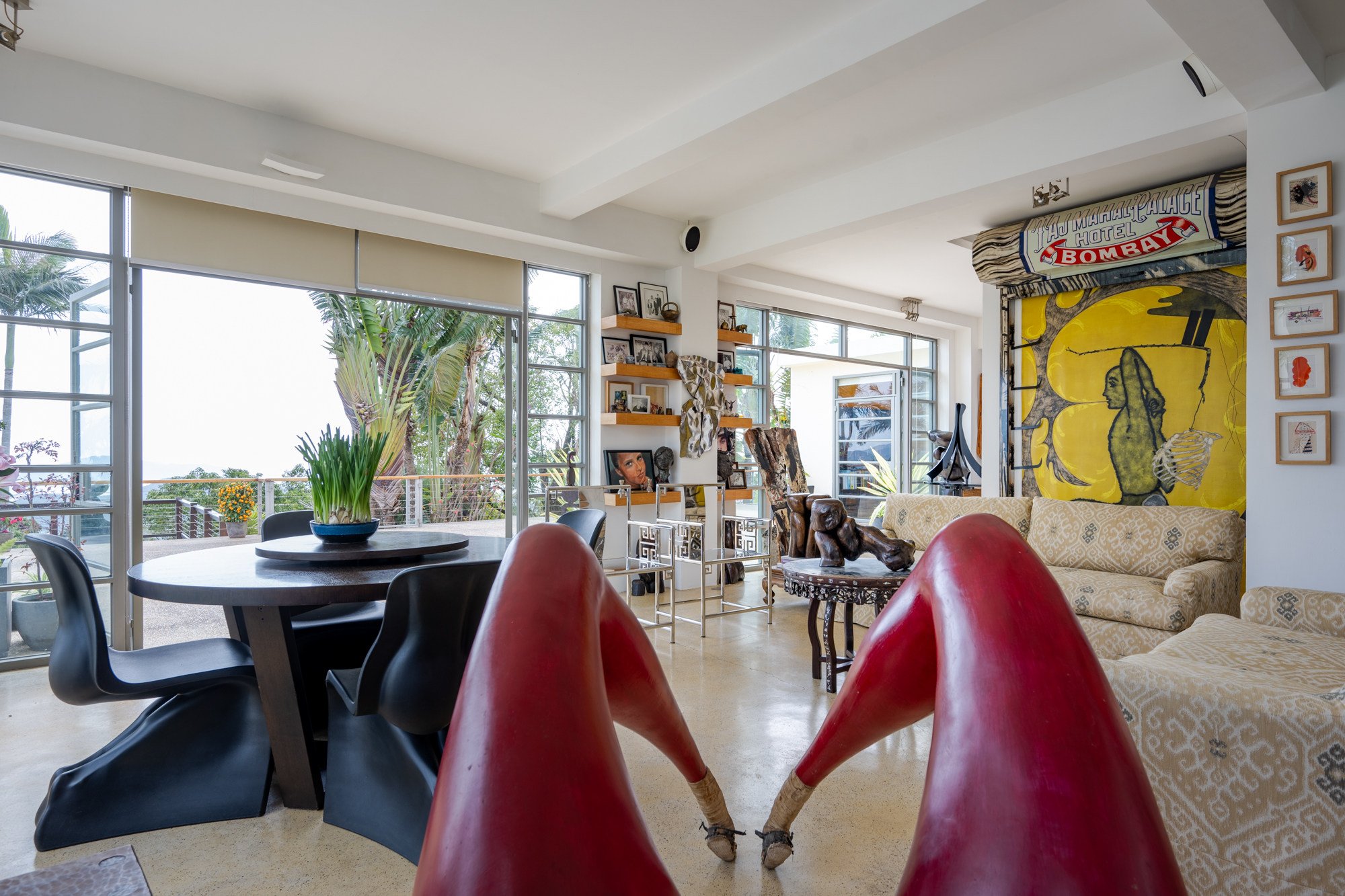
Sitting and casual dining area
In the sitting-cum-casual dining area, the red legs were bought at Xin Dong Cheng gallery (@xindongchengofficial on Instagram) in Beijing.
The dining table and its memorably curved chairs are from Shenzhen, as is the pair of stainless-steel, Ming-inspired chairs. A Wang Keping sculpture rests on an old-style Chinese table Georges de Tilly brought from New York.
Between the shelves of family photos is a “smashed-newspaper” work by Wang Du, which was bought in Beijing years ago. Near the shelves is a Frog King work from his first show, “Totem”, at 10 Chancery Lane Gallery (10chancerylanegallery.com) in 2014.
Atul Dodiya’s Taj Mahal Palace Hotel Bombay, from his Shutter series, is on the wall behind the sofa. Katie de Tilly bought at auction the five postcard-size works on the wall next to it, painted by Japanese artists in 1962 for the 11th Gutai Art Exhibition in Osaka. The sofas came from Altfield (altfield.com).
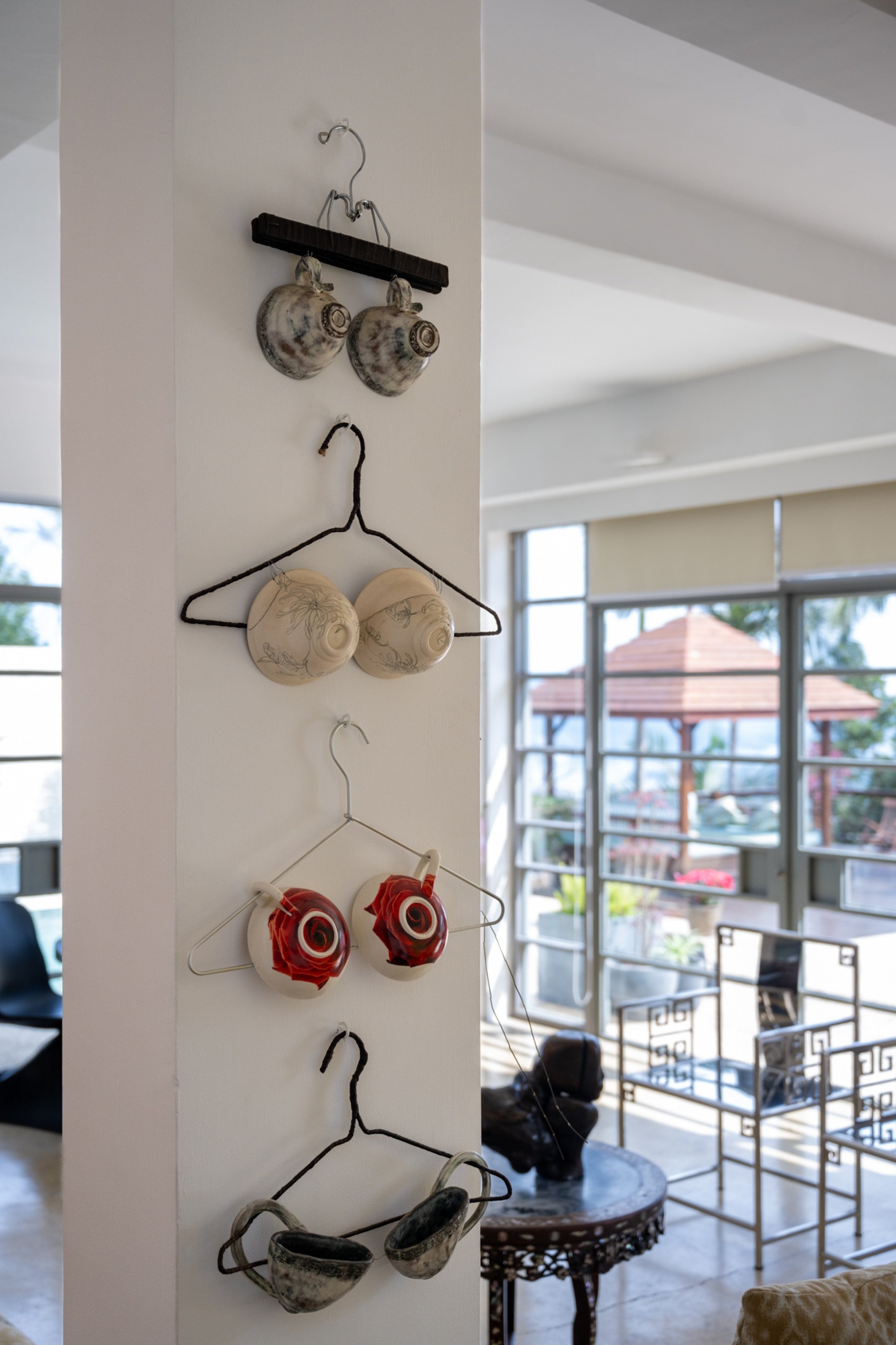
Living room detail
Four witty ceramic bras were made in 2004 by Irene Lau Kwai-ying. She now works as a dentist. “After Sars, it was hard for Hong Kong artists to make a living,” says de Tilly. “That changed during Covid. When galleries here couldn’t travel or ship, they took on more new Hong Kong artists.”
The large photographic mosaic is Khmer Reamker, by Vietnamese artist Dinh Q. Lê. The metallic “woman” and “person” Chinese characters on either side are by Huang Rui, from his Nu Ren series.
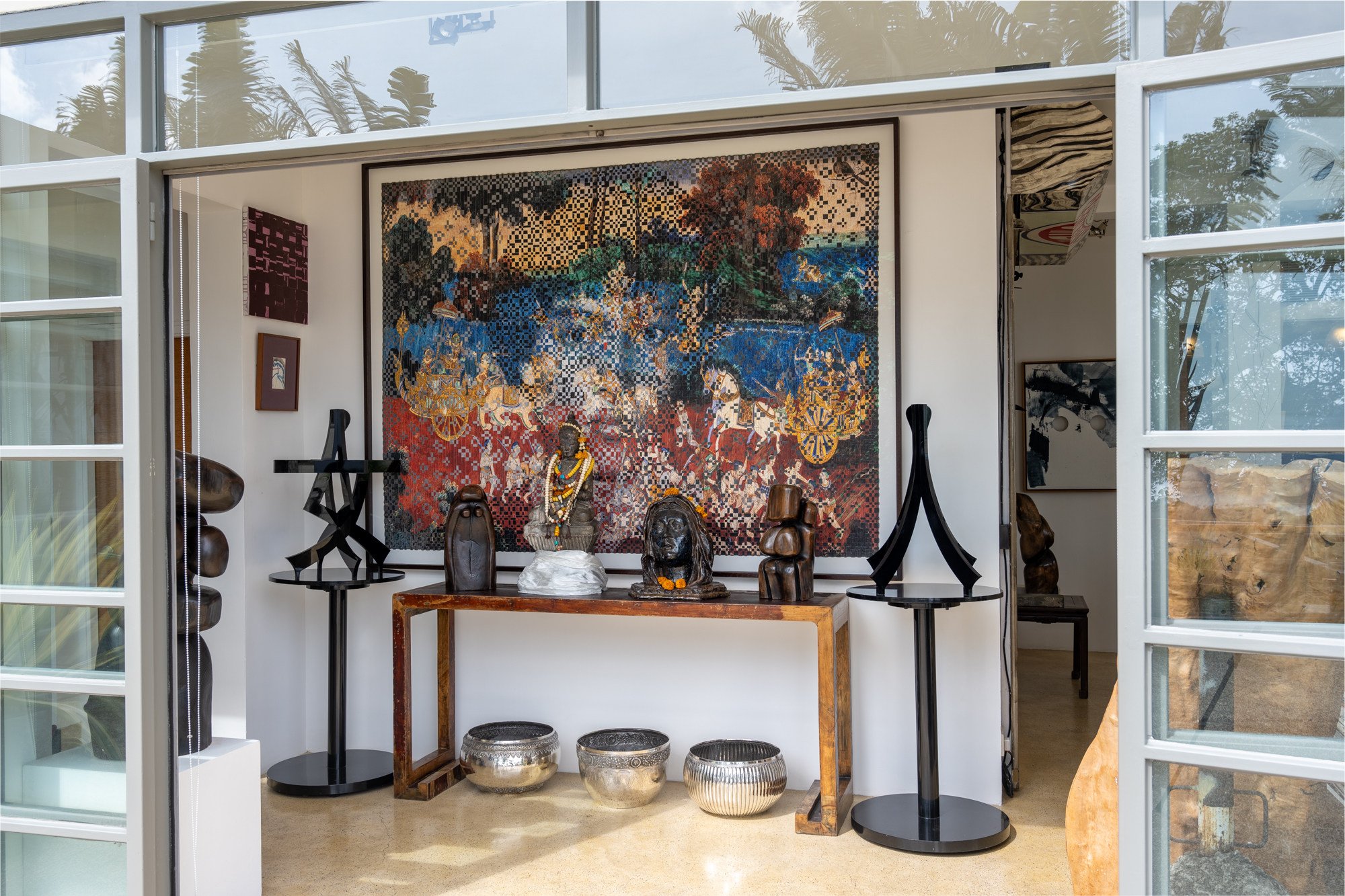
On the left wall is a Maria Taniguchi painting (top), which was bought at an Asia Art Archive auction (aaa.org.hk); the work below was also bought at auction, in Japan, and is by Kazuo Shiraga, a member of the Gutai Art Association.
The table was from Macau. On it is a sculpted head of the Virgin Mary, by Polish artist Paulina Olowska, that came from the Simon Lee Gallery (simonleegallery.com) in Hong Kong.
The Buddha was from Myanmar, as were the silver bowls underneath. The other two sculptures on the table are by Wang Keping.
Dining room
On the dining room wall is an untitled painting by American artist and director Julian Schnabel (julianschnabel.com). The dining table and chairs came from Shenzhen.
In the background, to the left, there’s a glimpse of an untitled Wang Keping work. The sculpted head was bought in Thailand. The two dragon candlesticks are Balinese.

Main bedroom
The floor of the main bedroom is made from oak grown in Georges de Tilly’s family’s forests in France. The rug was from Tibet. The altar table was bought in Macau “in the good old days”; the Madonna icon is from Poland; the headdress came from Bali (as did the shell boxes next to the bed) and the lacquerware was bought in Myanmar.
The All You Need is Love cushions came from France; the dragon ones were made from Shenzhen fabric that was originally intended for a coat.
The outdoors is the artwork in a Hong Kong home with stunning green views
The outdoors is the artwork in a Hong Kong home with stunning green views
Main en suite
The main en suite originally had a black tub but the de Tillys gutted the space and brightened it.
The eyes-and-nose painting is by Canadian artist Eliza Griffiths and was bought at ARCOmadrid (ifema.es/en/arco/madrid), Spain’s international contemporary art fair; it rests on a cupboard from Macau. The horned head was picked up in Myanmar; the small metal boots were bought in Hong Kong’s Cat Street.
The lacquerware box was a gift. Georges de Tilly bought the floor basket in Johannesburg, South Africa. The stone sculpture on the windowsill came from Lek Gallery Art (27/2 Charoen Krung Road, Bang Rak, Bangkok, Thailand, tel: +66 2 639 5871).
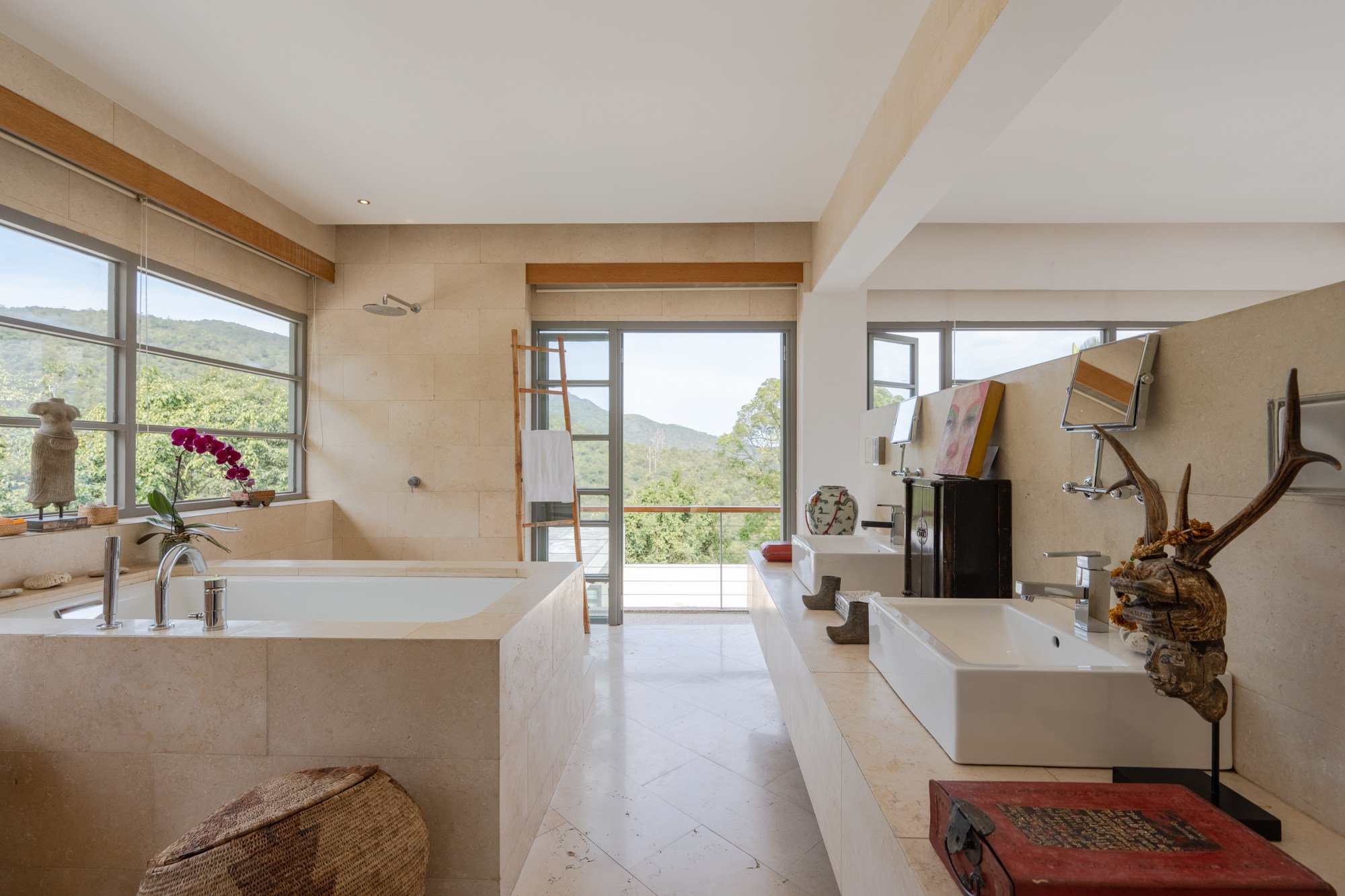
Deck
When the family moved in, the deck was already in place although the pergola resembled a Swiss chalet. They replaced the roof and redesigned it to look more modern-Asian.
The cushions were made by Wing Sun Upholstery (13/F, Harbour Industrial Centre, 116 Lee Nam Road, Ap Lei Chau, tel: 2871 9293). The skewed bench is by Thai artist Tawatchai Puntusawasdi, from his Tilted series.
The bronze sculpture, Woman Leaning, is by Wang Keping and was cast in Thailand in 2005. The palm trees were planted by the de Tillys.
Terrace
Katie de Tilly, who doesn’t believe in the easy (or predictable) option, challenges visual perception on a bench by Thai artist Tawatchai Puntusawasdi from his Tilted series.
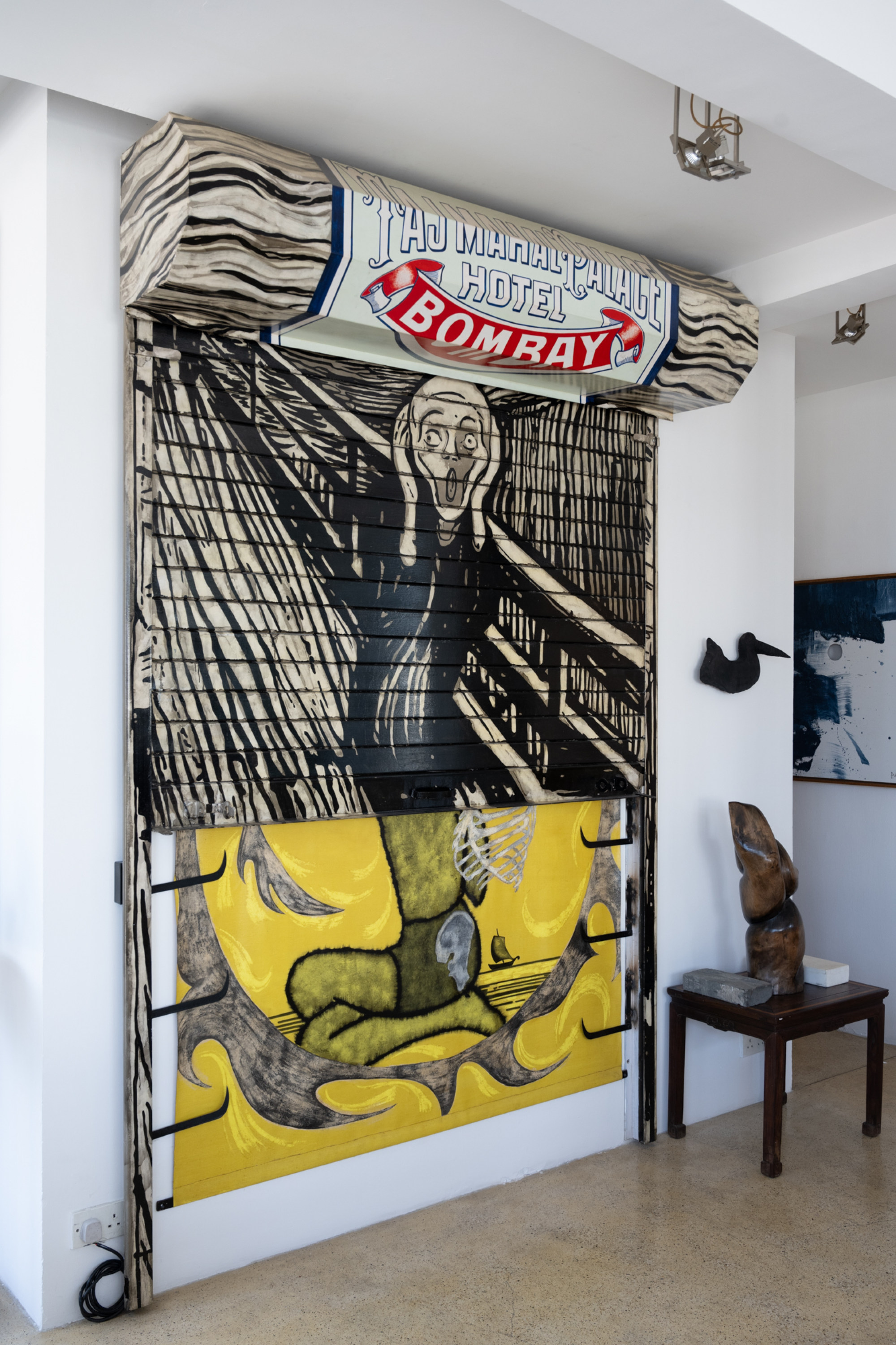
Tried + tested
Katie de Tilly’s 10 Chancery Lane Gallery exhibited Indian artist Atul Dodiya in 2013. His Shutter series was inspired by Mumbai’s shopfronts. The shutter mechanism makes it possible to show two works of art in a limited space.
For Taj Mahal Palace Hotel Bombay, Dodiya wanted to contrast Lord Krishna’s compassion with Edvard Munch’s The Scream (1893) – an original, and highly effective, statement in the living room.
